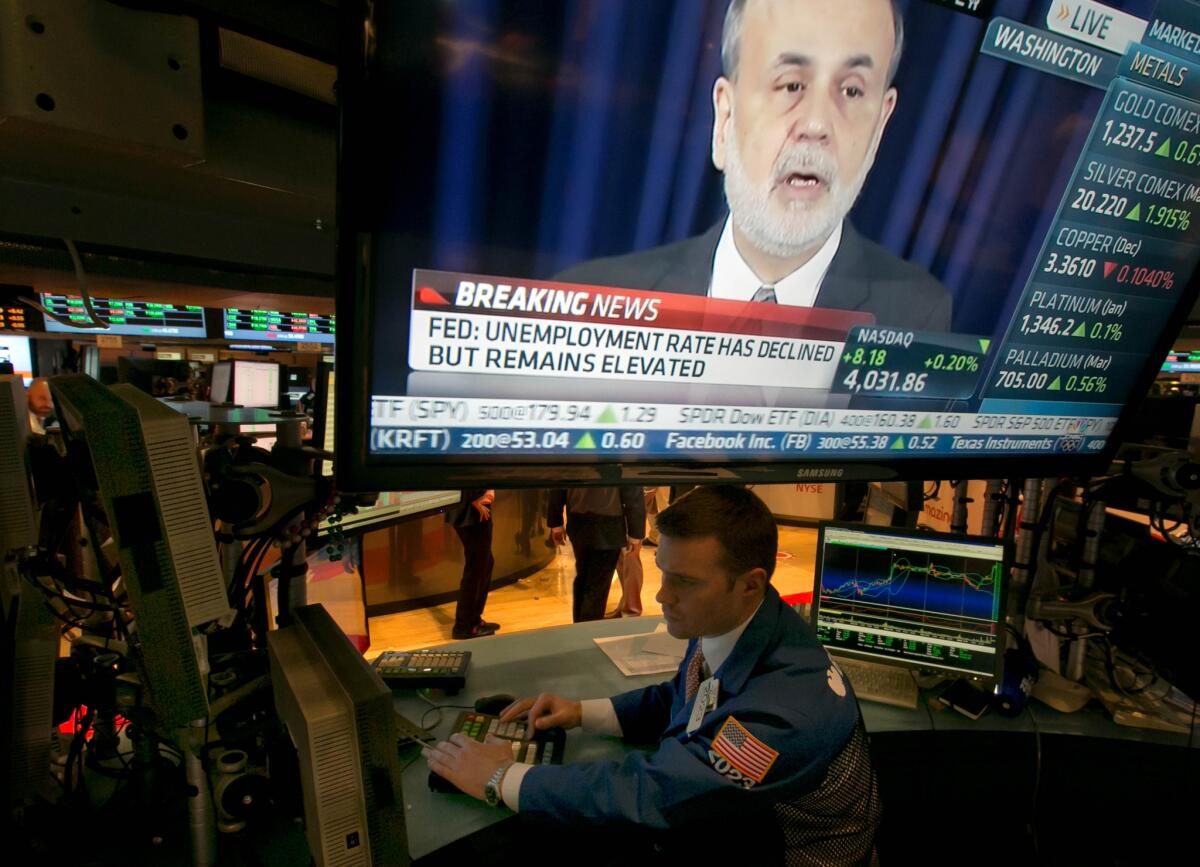The Fed starts to taper -- but doesn’t give up on easy money

- Share via
Nothing like a little sugar to help investors swallow a bitter pill from the Fed.
The Federal Reserve’s Open Market Committee announced Wednesday that it will finally start tapering its extraordinary efforts to stimulate the economy. Instead of printing enough money to buy $85 billion in long-term securities issued by the Treasury, Fannie Mae and Freddie Mac each month, it will buy $75 billion’s worth.
The move was more symbolic than substantive, considering how small the reduction was. But the message from the Fed was clear: It saw “growing underlying strength in the broader economy,” so it was time to finally ease up on the monetary gas pedal.
YEAR IN REVIEW: Politicians’ lamest apologies in 2013
You might think that good news about the health of the sluggish U.S. economy from some of the country’s preeminent economists might be welcomed by Wall Street. After all, stronger economic growth should translate into more revenue and better results for publicly traded companies, shouldn’t it?
But just the opposite has been true in recent months, with seemingly every encouraging development prompting a sell-off. That’s because investors feared what would happen once the Fed started reversing the easy money policies it adopted to stop the last recession from deepening into a depression.
And so the Dow plunged immediately after the Fed announced the start of tapering. But then investors noticed the sweetener the Open Market Committee threw into the announcement: It may not start increasing short-term interest rates when unemployment hits its previously stated target of 6.5%. The run on stocks quickly turned into a rally.
With the pace of job creation picking up in recent months, it appeared certain that the unemployment rate would drop below 6.5% in 2014. That created the possibility of a double whammy: The Fed would not only be curtailing its bond purchases (also known as quantitative easing), which had held down the cost of long-term borrowing, but also would be pushing up its target for short-term rates, which affects the cost of many types of credit.
The committee seemed to take this possibility off the table, saying it will probably be appropriate to keep short-term interest rates at the current target -- zero to .25% -- “well past the time that the unemployment rate declines below 6.5%, especially if projected inflation continues to run below the committee’s 2% longer-run goal.”
In other words, while the end of the Fed’s extraordinary stimulus efforts is approaching, its main easy money policy will continue until further notice. Considering how many times since 2009 the economy has appeared to be on the upswing, only to hit a new rough patch, that caution is well justified.
Investors’ fears about the end of tapering aren’t irrational. It will be no mean feat for the Fed to unwind its bond-buying program without damaging the economy, which has been buoyed by the Fed’s easy money policies. For starters, the interest rate on longer-term loans, such as mortgages, is likely to rise as the Fed slows its purchases, potentially squeezing the housing market again.
Yet the Fed can’t keep printing money forever. Yes, inflation has remained low by most indicators, but at some point the amount of money being pumped into the system will cause that rate to rise. Some critics of the program say the easy money policies have already created new asset bubbles, and the subprime mortgage fiasco amply illustrates why bubbles are a bad thing.
So, as one of his last acts, Fed Chairman Ben Bernanke started the delicate process of shifting the Fed out of the crisis mode it has been in for much of his tenure. He’ll step down in January, replaced by the Fed Board of Governors’ vice chairwoman, Janet Yellen, who is expected to be confirmed by the Senate later this week. He’s leaving investors -- and the economy -- with one last bit of sugarcoating, along with the implicit promise of more pills to come.
ALSO:
The dirty secrets of antibacterial soap
Kim Jong Un’s reign of fear: What’s next?
How to make high-speed rail work in California
Follow Jon Healey on Twitter @jcahealey and Google+
More to Read
A cure for the common opinion
Get thought-provoking perspectives with our weekly newsletter.
You may occasionally receive promotional content from the Los Angeles Times.







